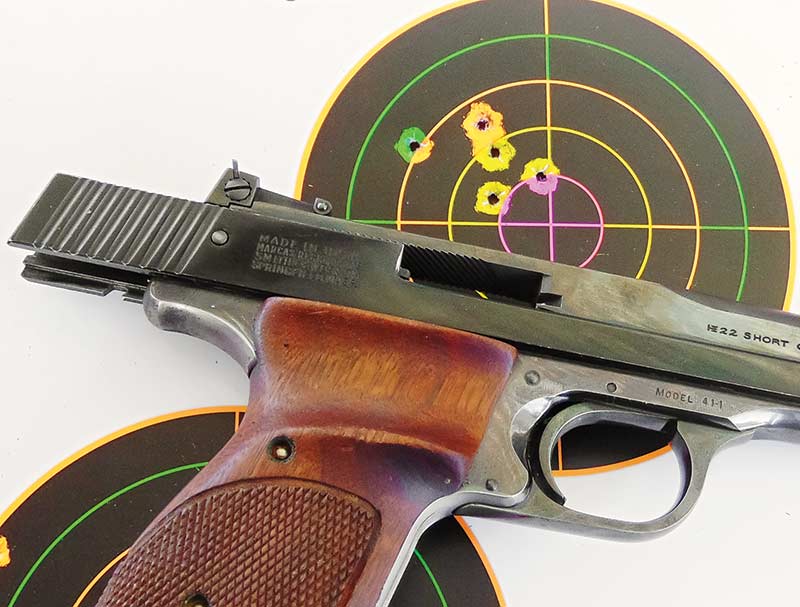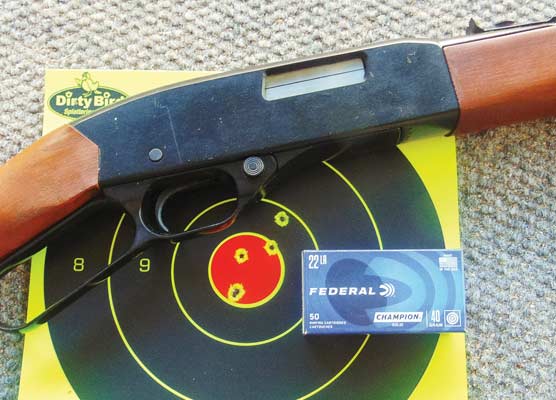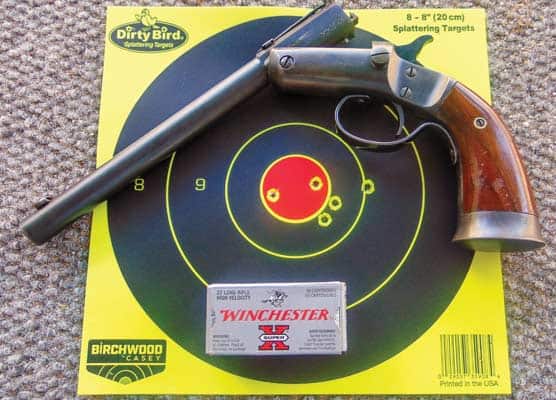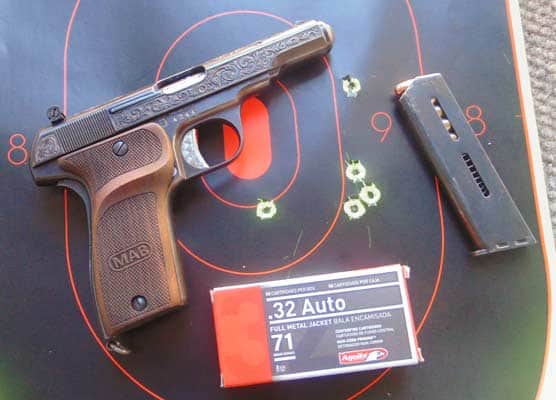S&W Model 41-1
Short-Stuff Olympian
Most of us look upon .22 pistols as recreational plinkers, beer-can poppers or small game guns so it’s easy to overlook how much rich history they have in formal competitive endeavors.
But .22 Long Rifle pistols, as ubiquitous as they are, weren’t always the be-all and end-all. Dedicated .22 Short target pistols designed specifically for International Rapid Fire competition once included such elegantly space-age items as the Walther OSP, Italy’s FAS Domino OP 601, Hi-Standard Olympic Rapid Fire and various Hammerli models.
Ready On The Line
We’re talking “specialized” here — a highly regimented competitive endeavor in which a relatively minuscule number of handgunners engage. So for the rest of us, perhaps a brief discussion of what Rapid Fire entails is probably in order.
In a nutshell, the course of fire consists of five shots fired at a series of five 25-meter targets — one-handed, of course — under time constraints of 8, 6 and 4 seconds.
These time limits are mercilessly “enforced” by the fact the targets are automatically turned to face the shooter at 90 degrees for the allotted time limit, after which they pop back. Here’s a brief excerpt from the regulations, courtesy National Rifle Association:
Shooting must start from the “READY” position. In the “READY” position, the competitor’s arm must point downward at an angle of not greater than 45 degrees from the vertical, but must not be pointed at the ground within the forward edge of the firing point. The arm must be stationary in this position while waiting for the appearance of the target or, when electronic scoring targets are used, for the green lights to come on.
Without getting into arcane dimensional detail, the 10-ring is a hair over 3.9″ and you get five tries to hit it or get as close as you can. We’re dealing here with an extraordinarily demanding level of “handgunnery.” Obviously, a low recoil impulse — coupled with a wondrous trigger — is essential.
A Short Answer
But that was then and this is now. Since 2004, .22 Short pistols are “non-kosher” for Olympic competition and have been replaced with .22 Long Rifle models.
But forgetting this particular stipulation for now, a competition-grade .22 Short pistol — outmoded as it may be for official competition — is still an absolute gas to shoot. Recoil and noise are literally next to nothing so if you’re looking for a discreet (although pricey) garden “gopher getter,” you could do a lot worse!
Vintage Olympian
Although most American shooters are familiar with the Smith & Wesson Model 41 in .22 Long Rifle, the rare variant Model 41-1 was introduced in 1960 and chambered in .22 Short. It featured a lightweight aluminum slide for reliable functioning with the smaller cartridge.
Only about 1,000 were produced, which probably accounts for the fact beginning auction bids generally start at well north of three grand. But it appears the auction gods must have been smiling on our shooting buddy John Wightman who managed to luck onto our test specimen for considerably less.
Obviously, .22 Short or not, the size and weight of the M41-1 are well above and beyond those of the usual tacklebox plinker. It weighs 41 oz. with a 7″ barrel (excluding brake) and a 10.5″ overall length. The weight, incidentally, is somewhat less than the allowable maximum for Rapid Fire, which is 1,400 grams — that’s a hair over 49 oz. for us metrically challenged Yanks.
Naturally, it’s a single-action blowback and could be had with a 5- or 10-round magazine. The grip angle is 105 degrees, the same as a 1911 service pistol. Ours had a trigger pull of 2.4 lbs. International rules for a 25-meter pistol stipulate a maximum pull weight of 1,400 grams (3 lbs.) and a minimum of 1,000 grams (2.2 lbs.), so our Model 41-1 was definitely in spec.
Here’s a heads-up for perspective buyers: That 5- or 10-round magazine isn’t easy to find so you’d best scour the usual sources if you’re committed enough to get a couple of backups. And be prepared for a bit of additional sticker shock in addition to the cash outlay for the pistol itself. As well, loading those tiny cartridges is a challenge for the fumble-fingered, particularly on a cold day.
We cheated a bit with non-competition grade ammo as well as the metric distance once required. The three .22 Short Loads we used included 27-grain CCI High Velocity HP (1,084 fps average), Winchester 29-grain Low Noise Solid (1,110 fps) and Remington 27-grain High Velocity HP (1,083 fps). Our shooting distance, from a sandbag rest, was 25 yards (which translates to 22.8 meters).
At 25 yards — granted, a touch shorter than the 25-meter distance Olympians must contend with — our best results came with CCI HPs. With this stuff, our 5-shot groups averaged just under an inch. Would we have done better with whatever Olympic-class ammo was available back in the day? I’d certainly like to think so. But we’d have been dealing with younger eyes on iron sights.
The Model 41-1 was never a staple in Olympic Competition. The High Standard was once the dominant American-made .22 used in Short or Long Rifle persuasion, but the M41-1 is a pretty nifty artifact from both a collecting and shooting standpoint.
The Model 41 in .22 Long Rifle is still offered by Smith & Wesson in both a Performance Center version (MSRP $1,679) and a Standard version ($1,429). Both are excellent, but the rarity and cool factor of the defunct “Shorty” 41-1 puts it in a class by itself.









